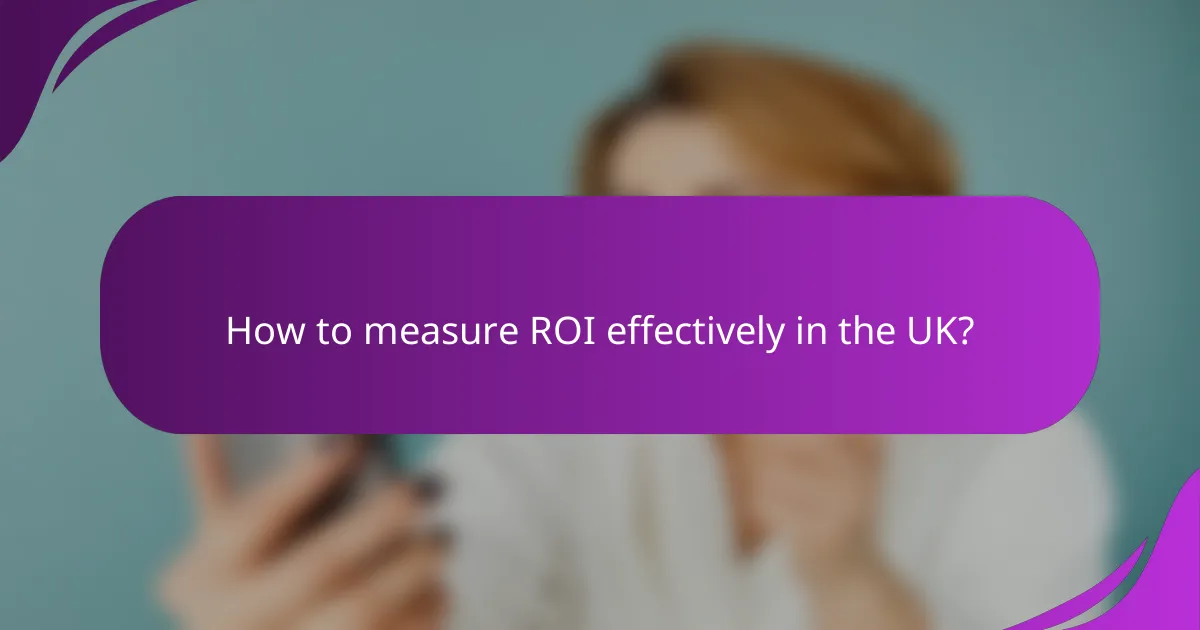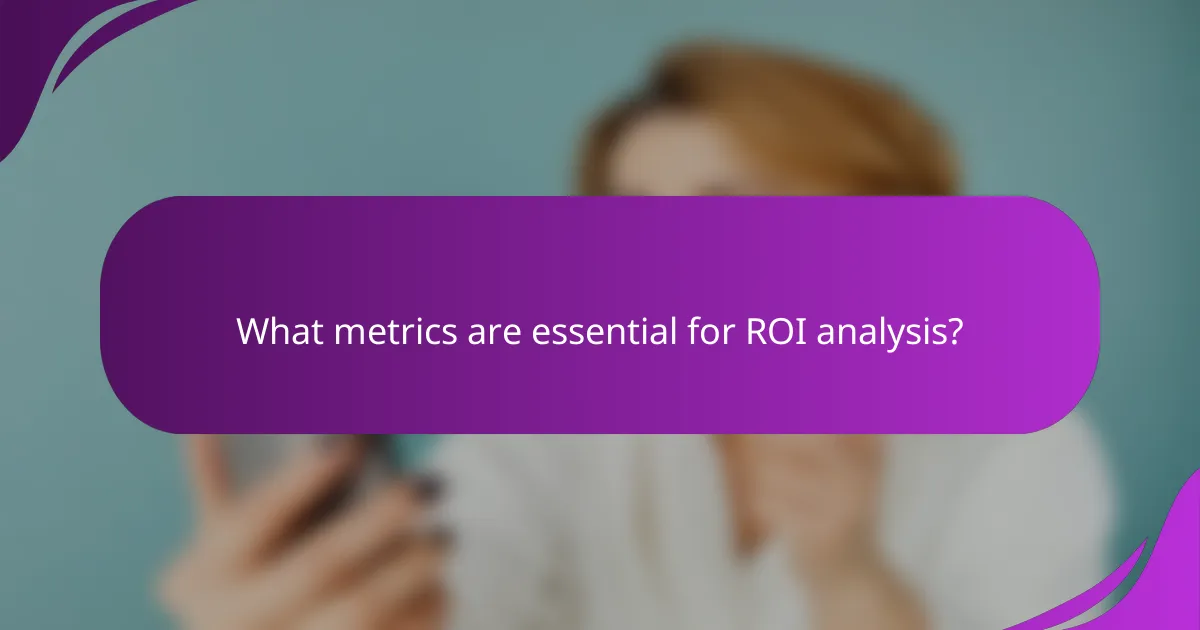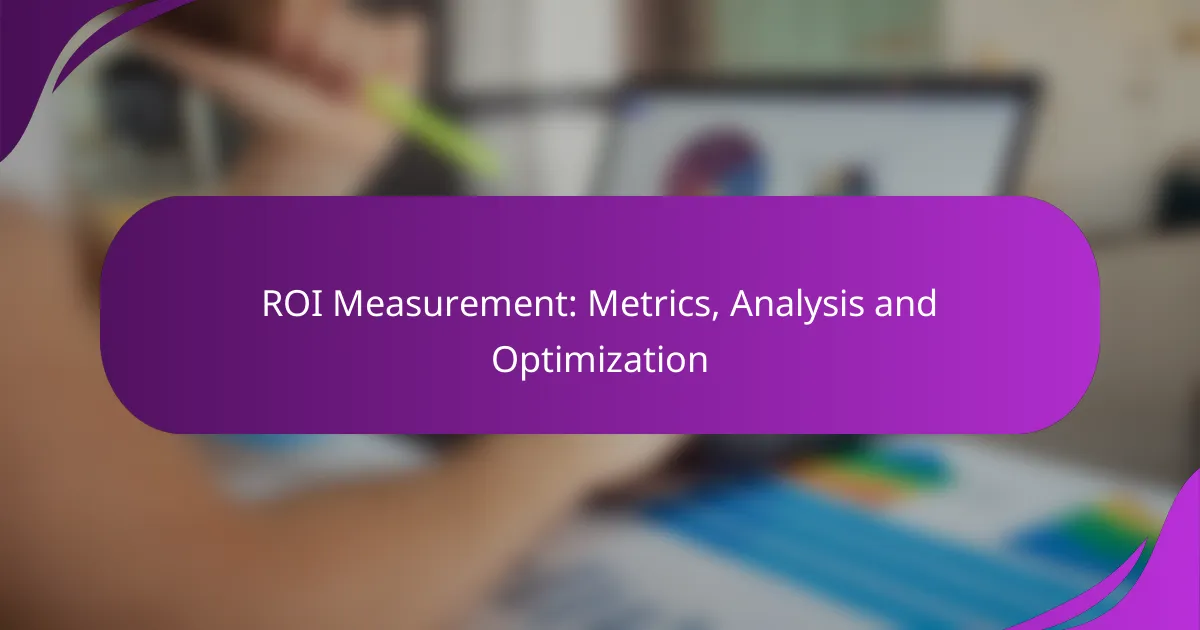Measuring ROI is crucial for businesses aiming to align their investments with financial goals. By focusing on key metrics such as cost per acquisition, customer lifetime value, and return on ad spend, companies can effectively evaluate their marketing strategies. Additionally, optimizing ROI in sectors like SaaS involves enhancing customer retention and leveraging data analytics to maximize revenue and minimize costs.

How to measure ROI effectively in the UK?
To measure ROI effectively in the UK, businesses should focus on clear metrics that align with their financial goals. This involves calculating the return on investment through various methods and utilizing key performance indicators to track progress.
Key performance indicators (KPIs)
Key performance indicators (KPIs) are essential for measuring ROI as they provide quantifiable metrics that reflect business performance. Common KPIs include customer acquisition cost, conversion rates, and customer lifetime value. These indicators help businesses assess the effectiveness of their marketing strategies and overall profitability.
When selecting KPIs, ensure they are relevant to your specific objectives. For instance, if your goal is to increase sales, focus on metrics that directly correlate with revenue generation. Regularly reviewing these KPIs allows for timely adjustments to strategies.
ROI calculation methods
There are several methods to calculate ROI, with the most common being the simple ROI formula: (Net Profit / Cost of Investment) x 100. This straightforward approach provides a percentage that indicates the profitability of an investment. For example, if an investment of £1,000 generates a net profit of £300, the ROI would be 30%.
Another method is the Payback Period, which measures the time it takes to recover the initial investment. This can be particularly useful for businesses looking to assess risk and liquidity. Understanding these methods helps in making informed financial decisions.
Tools for ROI measurement
Various tools can assist in measuring ROI effectively. Analytics platforms like Google Analytics provide insights into customer behavior and conversion tracking, which are vital for understanding ROI. Additionally, financial software such as QuickBooks can help in tracking expenses and revenues accurately.
Consider using dashboard tools like Tableau or Power BI to visualize ROI data. These tools allow for real-time monitoring and can highlight trends that inform strategic decisions. Choosing the right tools can streamline the ROI measurement process and enhance overall business performance.

What metrics are essential for ROI analysis?
Essential metrics for ROI analysis include cost per acquisition (CPA), customer lifetime value (CLV), and return on ad spend (ROAS). These metrics help businesses evaluate the effectiveness of their marketing strategies and optimize their investments for better returns.
Cost per acquisition (CPA)
Cost per acquisition (CPA) measures the total cost incurred to acquire a new customer. This metric is crucial for understanding how much you are spending on marketing and sales efforts relative to the number of customers gained.
To calculate CPA, divide the total marketing expenses by the number of new customers acquired during a specific period. For example, if you spent $1,000 on marketing and acquired 50 customers, your CPA would be $20. Keeping CPA low is essential for maximizing profitability.
Customer lifetime value (CLV)
Customer lifetime value (CLV) estimates the total revenue a business can expect from a single customer over the duration of their relationship. This metric helps businesses understand the long-term value of acquiring customers and informs budget allocation for marketing efforts.
To calculate CLV, consider factors such as average purchase value, purchase frequency, and customer retention rate. For instance, if a customer spends $100 per purchase, makes 5 purchases a year, and stays for 3 years, the CLV would be $1,500. A higher CLV indicates a more profitable customer base.
Return on ad spend (ROAS)
Return on ad spend (ROAS) measures the revenue generated for every dollar spent on advertising. This metric is vital for assessing the effectiveness of advertising campaigns and ensuring that marketing budgets are allocated efficiently.
To calculate ROAS, divide the total revenue generated from ads by the total ad spend. For example, if you earned $4,000 from a $1,000 ad campaign, your ROAS would be 4:1. A ROAS of 3:1 or higher is generally considered effective, but this can vary by industry.

How to optimize ROI in SaaS businesses?
To optimize ROI in SaaS businesses, focus on enhancing customer retention, refining marketing strategies, and leveraging data analytics. These strategies help maximize revenue while minimizing costs, ultimately leading to a more profitable business model.
Improving customer retention
Improving customer retention is crucial for maximizing ROI in SaaS. Retaining existing customers is often more cost-effective than acquiring new ones, with studies suggesting that increasing retention rates by just a few percentage points can significantly boost profits.
Implement strategies such as personalized communication, loyalty programs, and regular feedback loops to enhance customer satisfaction. For instance, offering tailored onboarding experiences can lead to higher engagement and lower churn rates.
Enhancing marketing strategies
Enhancing marketing strategies is essential for driving new customer acquisition and improving ROI. Focus on targeted campaigns that resonate with your ideal customer profile, using channels that yield the highest conversion rates.
Consider employing tactics like content marketing, SEO, and social media advertising to reach potential customers effectively. A/B testing different marketing messages can help identify what works best, leading to more efficient use of your marketing budget.
Utilizing data analytics
Utilizing data analytics allows SaaS businesses to make informed decisions that can lead to improved ROI. By analyzing customer behavior, usage patterns, and financial metrics, you can identify areas for improvement and optimize your offerings.
Implement tools that provide insights into customer interactions and sales performance. Regularly reviewing this data can help you adjust strategies quickly, ensuring that resources are allocated effectively and ROI is maximized. Consider using dashboards to visualize key metrics for easier decision-making.

What frameworks support effective ROI measurement?
Effective ROI measurement is supported by frameworks that provide structured approaches to evaluate performance and align goals. Two prominent frameworks are the Balanced Scorecard and the SMART goals framework, each offering unique methodologies for assessing return on investment.
Balanced scorecard approach
The Balanced Scorecard is a strategic planning tool that translates an organization’s vision and strategy into a comprehensive set of performance measures. It focuses on four perspectives: financial, customer, internal business processes, and learning and growth, ensuring a balanced view of performance.
To implement this approach, organizations should identify key performance indicators (KPIs) for each perspective. For example, financial metrics might include revenue growth, while customer metrics could focus on satisfaction scores. Regularly reviewing these KPIs helps in making informed decisions and optimizing strategies.
SMART goals framework
The SMART goals framework is a method for setting clear and achievable objectives that enhance ROI measurement. SMART stands for Specific, Measurable, Achievable, Relevant, and Time-bound, ensuring that goals are well-defined and trackable.
When using the SMART framework, organizations should create goals that are specific to their ROI objectives. For instance, instead of stating “increase sales,” a SMART goal would be “increase sales by 15% within the next quarter.” This clarity aids in monitoring progress and making necessary adjustments to strategies.

How does ROI impact business decisions in the UK?
ROI, or Return on Investment, significantly influences business decisions in the UK by providing a clear metric for evaluating the profitability of investments. Companies use ROI to determine which projects or initiatives yield the best financial returns, guiding resource allocation and strategic direction.
Budget allocation
Effective budget allocation relies heavily on ROI analysis, as it helps businesses identify which areas will generate the highest returns. By comparing the expected ROI of different projects, companies can prioritize funding towards initiatives that promise better financial outcomes.
For instance, if a marketing campaign shows an anticipated ROI of 150% while a new software implementation shows only 80%, the business may choose to allocate more budget to the marketing effort. This strategic choice maximizes the potential for profit and supports overall financial health.
Strategic planning
ROI plays a crucial role in strategic planning by allowing businesses to assess the long-term viability of their initiatives. Understanding the ROI of various strategies helps companies make informed decisions about where to invest their resources for sustainable growth.
When developing a strategic plan, businesses should consider both short-term and long-term ROI. For example, investing in employee training may yield lower immediate returns but can lead to higher productivity and profitability over time. Balancing these perspectives is essential for effective strategic planning.

What are the emerging trends in ROI measurement?
Emerging trends in ROI measurement focus on leveraging advanced technologies and real-time data to enhance accuracy and decision-making. Businesses are increasingly adopting innovative tools that provide deeper insights into their investments and performance metrics.
AI-driven analytics tools
AI-driven analytics tools are transforming ROI measurement by automating data analysis and providing predictive insights. These tools can process large volumes of data quickly, identifying patterns and trends that human analysts might miss.
For example, platforms like Google Analytics 4 utilize machine learning to forecast user behavior, allowing businesses to adjust their strategies in real-time. Companies can expect to see improved ROI by using these tools to make data-driven decisions.
Real-time data tracking
Real-time data tracking enables businesses to monitor their ROI metrics as they happen, rather than relying on historical data. This immediacy allows for quicker adjustments to marketing strategies and operational processes, enhancing overall performance.
Tools like Tableau and Power BI offer dashboards that visualize key performance indicators (KPIs) in real-time. Organizations can benefit from this trend by ensuring they have the right data integration systems in place to capture and analyze data continuously.
Predictive modeling for ROI
Predictive modeling for ROI involves using statistical techniques to forecast future returns based on historical data. This approach helps businesses anticipate the outcomes of their investments and allocate resources more effectively.
For instance, companies can use regression analysis to predict how changes in marketing spend might affect sales. By implementing predictive models, businesses can optimize their strategies and potentially increase their ROI by making informed decisions based on anticipated results.
